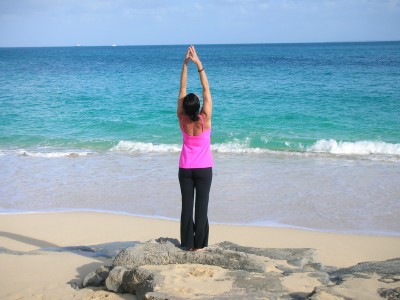I started to think about this concept as it applies to yoga practice. There are a number of poses we may do that, if done without awareness, will “exploit†certain muscles or joints. By the same token, there are poses and movements we can do with greater ease and integrity if we perform them while “recruiting†the muscles we need in order to create the greatest stability and with it, a good stretch.
The overall idea in yoga is to move in an integrated way where all the muscles, joints, tendons, ligaments and bones are moving smoothly and there’s balance between strength, flexibility and relaxation so that the practitioner feels they are not only getting stronger but they are also relaxing.
Recruit core and legs in Low push up; resist exploiting the shoulder. When we move from High to Low Push Up, it’s an upper body strengthener. But, if we only use our upper body and neglect to use some leg and core strength, the entire weight of the body falls to the shoulders to bear. As you move, press your heels back to engage your quadriceps. Draw in the sides of the waist to engage your transversus abdominus (the muscle that wraps around your waist like a corset). Hug your elbows into your ribs to recruit your serratus anterior (the muscle that wraps from your ribs around to the inside border of your scapula on both sides). Bringing these muscles into the movement will even out the weight of the body.
Recruit more abdominal muscles in lunges; resist exploiting the lumbar spine. As we move into lunges like Crescent Lunge and Warrior 1 and even in poses like Chair, we may create a sway back shape, exploiting the mobility in the lumbar (lower) spine and thrusting the chest and upper ribs forward. This puts unnecessary pressure on the back. To correct, recruit the core muscles and draw the abdomen in to reverse the sway back.
Recruit more abdominal muscles in low lunges; resist exploiting the hip and knee joint. In low lunges like Lizard pose, or a deep hip stretch like Frog, we can exploit the hip and knee if we just “hang†in the joints. Recruit the abdominal muscles to create a stable base off of which the muscles can stretch.
Recruit more quadriceps and gluteus medius in poses on one leg; resist exploiting the knee joint. When balancing, we may lock the knee joint on the standing leg and end up in hyperextension (locking the joint). Recruit the quadriceps muscle on the straight leg by slightly bending the standing leg. This will prevent hyperextension. Also, focus on steadying the leg by recruiting the gluteus medius (outer hip) muscle. This can be achieved by slightly contracting the roundness of your hip on the straight leg side. These two actions will prevent hyperextension.
Recruit more adductors in backbends; resist exploiting the external rotators and the shoulders. As we do backbends like Upward Bow or Bow, we may widen the knees and/or turn the feet out which compresses the lower spine and makes it harder to bend. Recruit more of the adductor muscles: the muscles on the inner thighs. You could squeeze a block between your thighs to remind you to keep the feet straight and the inner thighs active. This will allow you to bend with greater ease.
Recruit more thoracic spine in backbends; resist exploiting the cervical and lumbar spine. As we move into any backbend, the body will try to move from the neck and the lumbar (lower) back because those move more easily than the thoracic (middle) spine. The 12 thoracic vertebrae and their attachments to the ribs make that part of the spine much less moveable. As you move into backbends, recruit your rhomboids, the muscles that squeeze your shoulder blades together. Don’t shove them together; but bring more awareness to that movement so you start to create a bend in the middle back as well.
Recruit more quadriceps and abdominal muscles in Downward Facing Dog; resist exploiting the wrists and shoulders. If done without any awareness in the lower half of the body, the body will slump into the upper body given it’s an inversion (your head is lower than your heart). Resist exploiting your wrists and shoulders. If you’re particularly flexible in the shoulder, you may end up pressing back into your legs and straining it. Recruit more of your abdominal and quadriceps muscles to balance the pose’s effort between the upper and lower body.
The ideas presented are designed to bring greater awareness to the body, designed to create healthy patterns of movement on the mat that will translate into better patterns of movement off the mat as well.

